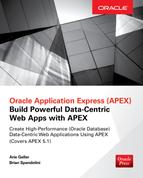Book Description
This Oracle Press guide shows how to build and deploy powerful Web applications with Oracle Application Express and features full coverage of the latest version, APEX 5.0
This comprehensive volume from Oracle Press offers up-to-date coverage of Oracle Application Express (APEX), Oracle’s rapid development tool for the Web developer. APEX is an entirely Web-based framework that comes built into every edition of Oracle Database—its backbone is Oracle’s powerful PL/SQL language, alongside the most advanced Web development technologies like HTML5, mobile development, and full support of CSS and JavaScript. APEX enables anyone—from novice user to seasoned developer—to easily create Web applications that are powerful, reliable, and highly scalable.
Oracle Application Express: Build Powerful Data‐Centric Web Apps lays out basic information about APEX concepts before delving into the unparalleled power of the platform and describing the new features in version 5.0. You will discover how to install and configure APEX, work with the Application Builder and Page Designer, use built-in wizards, and design custom Web apps.
- Teaches the cleanest and fastest builds for high-performance, secure web applications
- Shows how to effectively migrate legacy applications into a modern Web-based environment
- Authored by early adopters of APEX 5.0 who have been active in the APEX community for years
